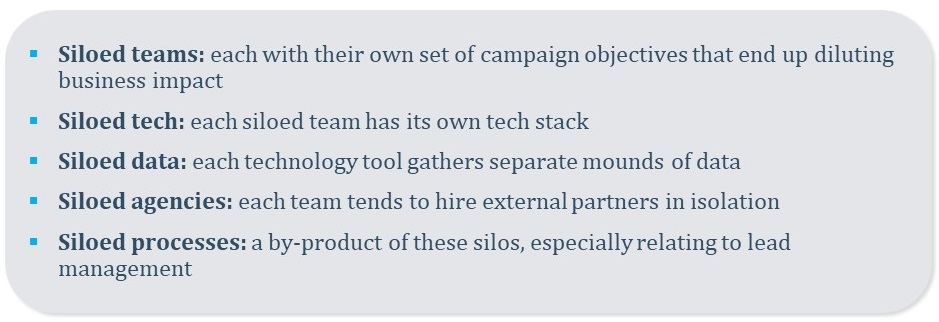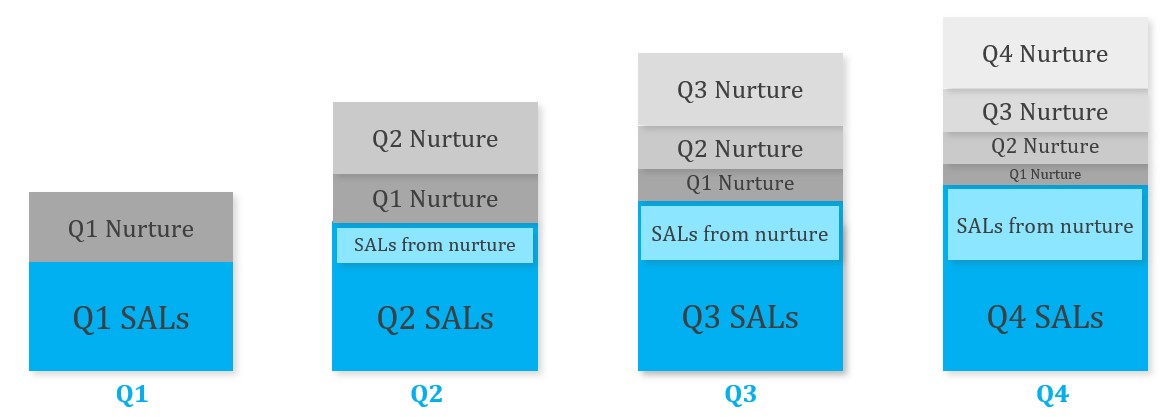Internal silos in teams, content, data and tech are common and can erode your buyer experience, your organizational culture, growth and revenue, but only if you let them.
Silos hinder alignment, collaboration and so growth and revenue. In a B2B enterprise company this is a common problem as rapid growth has led to data, tech and teams isolated from each other.
While the experience economy ramps up, B2B buyers are increasingly demanding an omnichannel and connected buyer experience. Yet, reports show that while 76% of customers expect consistent interactions across departments, only 54% of customers think that sales, services and marketing teams share information [Dimension Data’s CX Benchmark Report, 2020]. This is a problem as “70% of customers spend more with companies that offer fluid, personalized, and seamless customer experiences.” [Zendesk Customer Experience Trends Report 2023]. As tech becomes more sophisticated and decision-makers demand greater personalization, B2B enterprises must unify data, teams, tech and processes to offer a joined up CX or lose out to the competitor who does.
79% of marketing leaders said that their organization’s marketing and sales teams were misaligned to some degree. [Salesforce]
90% of companies say that siloed teams are having a negative impact on the customer experience. [InsideView]
How silos happen
Silos are endemic but how are they created in the first place?
- Employee churn can mean poor handovers and lack of accountability as responsibility is passed over.
- Focus can be on fast-tracking revenue rather than on long-term strategy that might be difficult in its implementation phase, but which will benefit the organization over time.
- New tech platforms can be quickly adopted to fix a problem but then ditched when the solution doesn’t happen fast enough, leading to data isolated from other systems.
- A new leader can introduce new tech and processes without integrating legacy systems and processes, leaving legacy systems and integrations stuck.
- In some organizations, there’s a silo mentality where teams are reluctant to share information, data and insights with another, which negatively impacts company culture, team morale and results.
The problem with silos
Breaking down silos may seem too complex, time-consuming and costly but it must be done. Here are some of the reasons breaking down silos should be a top priority for B2B organizations:
You don’t have a single view of your customer or your business
Fragmented data and analytics makes it difficult to gain a holistic view of customers, products, or market trends. Understanding the complete picture is important to glean valuable insights, identify growth opportunities, personalize offerings, iterate future strategy and be able to link revenue to program performance.
Inconsistent data
If data is stored by separate departments in separate systems, these disparate assets not only make analysis more time-consuming, but your data is liable to be more inconsistent as conflicts, duplicates and incompatibilities slowly invade your information. This in turn leads to an erosion in trust in the data you collect. Consolidating and managing this fragmented data also means increased costs. A survey of data professionals found that on average they spent 56% of their time on operational execution and routine data management, which meant only 22% of their time was given to innovation that added value [Gartner, 2020].
Inconsistent messaging leads to poor CX
When customer teams are disseminating a different message to marketing, and sales has its own content, the customer is receiving mixed messaging, passed from department to department for the right answer. This lack of consistency hinders the ability to deliver a seamless customer experience across different touchpoints, eroding brand trust, increasing customer churn, and negatively impacting on revenue growth.
Distrust between teams & lack of unified company culture
When teams have their own strategy and goals, they can sometimes be at odds with another internal team. Without organization-wide goals, resources are not utilized effectively as teams work towards their own micro-targets instead of those of the business. Teams working independently can also result in reduced knowledge sharing, inefficient workflows, and duplication of efforts.
Missed cross-sell and up-sell opportunities
Cross-selling and upselling requires coordination between sales, marketing, and customer service and silos can make it difficult to share customer purchasing history, customer feedback, or identify complementary products or upgrades. Caroline Japic, Chief Marketing Officer at Pramata, eloquently explains in her Forbes article, Three Tips for B2Bs When Cross-Selling and Upselling: “The challenge often is not around finding more stuff to sell—it’s knowing what stuff’s already been sold. Surprisingly, many B2B organizations struggle to lay their hands on that information. Like other key data points—contract renewal dates, customer commitments, pricing and discount agreements—it has to be extracted from the dense legalese of contracts and assembled from multiple systems that don’t communicate well with each other.”
Slower business-decision making & ineffective strategy
When teams are forced to spend time tracking down the data they need plus ensure it is complete and are unable to streamline it across the organization, those important business decisions have to wait; a time lag that your competition will happily exploit to reach the limited pool of buyers faster. This general lack of agility hampers go-to-market time and impacts revenue. Many firms recognize the importance of tackling data silos – in a recent report, 62% of financial leaders said improving access to siloed, distributed data is a top initiative and 54% cited data silos as one of their biggest barriers to innovation [WBR Insights]. Research shows that 80% of companies report high or moderate degrees of data silos and 69% are unable to provide a comprehensive, single customer view.

Tearing down the walls of silos
The first step to dismantle legacy silos must be to map a shared vision that marketing, sales, and customer success teams can understand and align themselves behind so that you can drive the business forward with a well-built strategy.
At MarketOne, we saw the need for a new approach for our enterprise clients and so we’ve developed a solution. It’s an account-based approach driven by a highly experienced team, designed to surround the buying team and make contact and engage them at every step along their buyer journey. With a single goal (more conversions) and mapped out processes to achieve it (SDR / BDR driven, account-targeting through sequencing and 1-1 engagement), every member of the sales and marketing teams knows where they’re heading, with specific steps, measurement and accountability along the way.
Introducing SD360™ – full circle prospect engagement
SD360™ is an always-on sales development and account-based marketing (ABM) engine, pioneered by MarketOne. It inputs account lists and outputs sales-ready leads (SALs), maximizing conversions into sales. We do this by unifying siloed sales and marketing touchpoints, both digital and human, providing the B2B buyer with a unified 360° experience. Emails, social selling, microsites, landing pages, calling and sales sequences are brought together holistically to break down internal silos, drive higher conversions and create a measurable impact on revenue.
How SD360™ unifies silos to boost growth and generate revenue
With its central framework, SD360™ is a managed service that aligns teams, data, tech, reporting, systems and processes. Instead of each team handing over the baton to another in a linear construction of the customer journey, SD360™ recognizes that today’s buying process is non-linear, based on buying groups rather than individual prospects and requires omnichannel engagement. It brings together outbound sales lead development and inbound lead sales qualification to surround buyers with a coordinated and holistic mix of digital and human touches.
Unified technology
SD360™ provides a centralized tech stack where collaborative data tools, CRM and MAP keep departments engaged with each other, collaborating and on the same page. With this approach, there are no multiple, redundant tools or overlapping systems, just a unified engine that works converts leads to conversions.
Unified data
Only 22% of business leaders say their teams share data well [Zendesk]. SD360™ is an all-in-one-solution that ensures all relevant data is accessible, up-to-date and stored in one easy-to-share central location. Account and contact data is imported via integration, API or flat-file transfer, so it can be worked on and managed on the platform. A single dashboard provides easily accessible analytics and insights, allowing you to unlock data value via a holistic view of your information.
Unified teams
Marketing and sales have the same KPIs and a robust lead management process. SD360™ creates visibility between sales and marketing so each can see contribution to conversions, which encourages further alignment. This goes further than simply reducing friction between the handover and hand back between marketing and sales – rather it’s an approach that recognizes that only a mix of digital and human communications delivered by both marketing and sales development can provide the buyer with all the necessary information to complete necessary buying jobs to make the, sometimes complex, purchase.
Unified sales intelligence
Valuable leads don’t slip out of the net – leads are identified and qualified by the SD team and relationships are carefully nurtured with one-to-one conversations. Marketing and sales development are customer-focused and tailored for the specific account, customizing the experience to the buyers’ needs. Insights are uncovered in real time for immediate follow-up or long-term nurture. Importantly, when SD360™ is up and running, future leads are never discarded but further nurtured until they’re ready to convert, generating maximum ROI from the investment in each campaign when repeated quarterly.
Leads identified for nurture contribute to SALs in subsequent quarters

Unified reporting
Data is tracked and reported through one integrated platform, providing a connected customer view. SD360™ reports on number of contacts developed and qualified; conversion rates; performance of pipeline, sequences, one-to-one email engagement and landing page engagement; source and campaign analysis; data quality benchmarks; plus regional performance and global roll-ups. Together, this provides deep, actionable insight to drive targeted marketing and sales.
Unified tactics
SD360™ is always on and so is more beneficial to your bottom line over the long term than the shotgun tactics of a single ‘one and done’ campaign. While these may generate low cost-per-lead and net-new-contact acquisition, quality of leads is often low meaning the cost of conversion to sales is very high and they reinforce existing silos. SD360™ is a joined-up approach for your go-to-market efforts that puts the right solution in front of the right buyers are the right time. It focuses on long-term impact and results as leads are kept warm until they’re ready to buy and delivers a more cost effective conversion to sales.
Unified buyer experience
When you have aligned all of the above, your buyer receives consistent messaging across all channels, and as departments are collaborating, they receive the information they need at the right point in their journey. No more being passed from department to department for an answer, no conflicting information, no contradictory or disjointed campaigns. When you have successfully eradicated silos, your buyer is a recipient of your harmonious marketing and sales efforts that give them the trust and confidence in your brand to make a purchase. Want to find out how to unify silos to create a Unified Buyer Experience (UBX) to satisfy your buyer and drive growth.
No more silos: the beauty of SD360™
Silos are destructive to the growth and revenue of B2B enterprise companies –isolated data, teams, systems and processes hinder the necessary collaboration and customer-focus that’s required to stay ahead of the competition. In our burgeoning experience economy, buyers expect and demand businesses to provide personalized experiences. SD360™ is a holistic solution that works each account, tailoring messaging, content and engagement to specific buyer pain points and needs. As marketing and sales development unite behind a single strategy, technology platform and set of processes, silo walls are broken down. Consequently, resources are saved, cost of conversion to sales is optimized, and different elements of the business start to work in harmony. The buyer is a recipient of this united front, receiving a unified buyer experience (UBX) and a frictionless, joined-up buyer journey as each touchpoint is tailored, mapped and integrated. This shift towards a unified experience for the buyer must start internally – B2B enterprise companies can no longer get away with siloed operations if they want to survive in this brave new business landscape.


